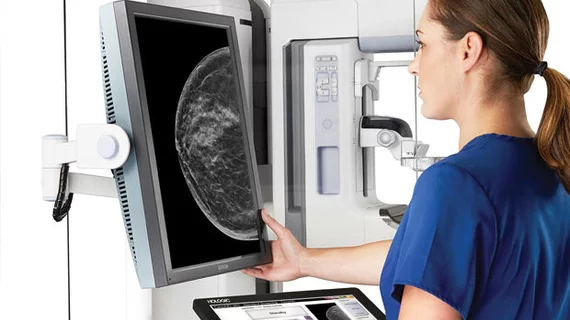Specially trained radiographers spot breast cancer at rates comparable to radiologists
Radiographers trained to recognize certain findings on screening mammograms could help address the worldwide shortage of radiologists.
That’s according to new research published in Radiology that details a double reading method that is commonly used in Europe. Double reading involves a radiologist’s interpretation of imaging in addition to a non-radiologist's input—in this case a specially trained radiographer.
The National Health Service Breast Screening Program (NHSBSP), which has more than 80 screening centers in England and completes more than 2 million screening mammograms annually, in the United Kingdom recruits radiographers who have completed extensive postgraduate education to assist in the interpretation of mammograms. This, in turn, helps reduce the workload burden of radiologists who are often short-staffed.
It sounds like a reasonable solution, but is it effective? According to the performance data derived from more than 1 million screening digital mammograms—yes.
Researchers arrived at this conclusion after reviewing a year’s worth of interpretations from 224 radiologists and 177 radiographers from the NHSBSP, each of whom had completed quality assurance training specific to mammographic screening prior to the analysis. Reader performance was judged based on three metrics—cancer detection rates, recall rates and the positive predictive value of recalls based on biopsy-proven findings.
For cancer detection rates, researchers did not observe a significant difference between the radiologists and radiographers (7.84 per 1,000 vs 7.53). Recall rates were also neck and neck, at 5% for radiologists and 5.2% for radiographers. And the final performance metric—positive predictive value of recall—was also in line with the first two metrics for each group, at 17.1% for radiologists and 16.1% for radiographers.
“It has been really gratifying to show that there was little difference in the performance of readers from either professional group when we looked at the key breast cancer screening performance metrics of cancer detection rates, recall rates and positive predictive value of recall,” said study co-author Jonathan J. James, FRCR, consultant radiologist and Director of Education and Training at the Nottingham Breast Institute at Nottingham University Hospitals NHS Trust.
The authors of the study suggested that mammographic screening with double reader methods could be of great benefit in low resource countries where the expertise of radiologists might not be immediately available.
The study can be viewed here.

